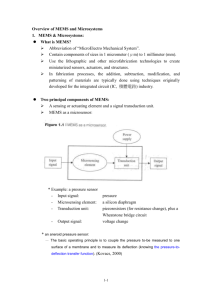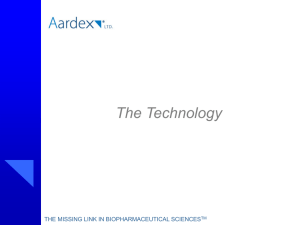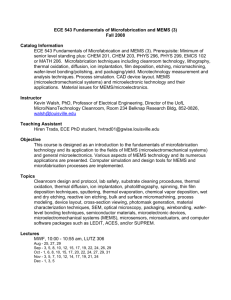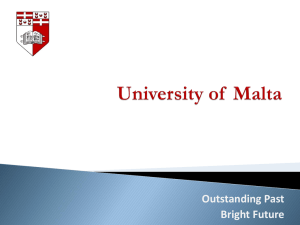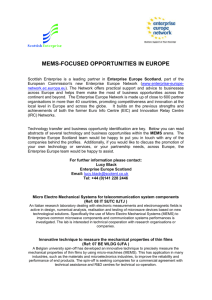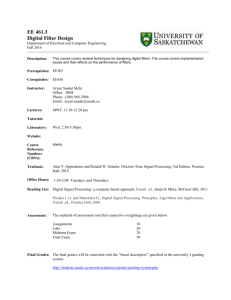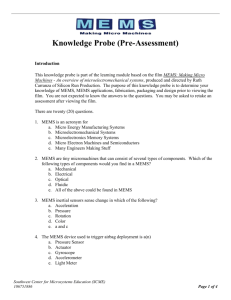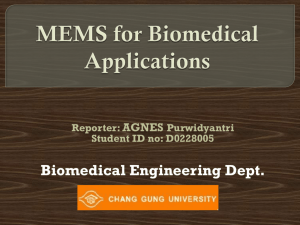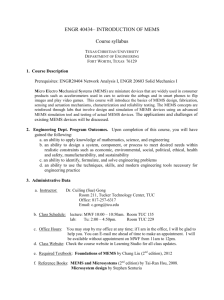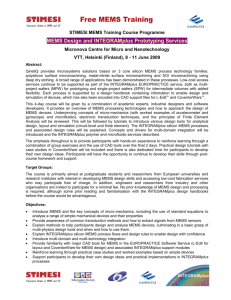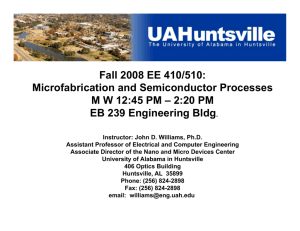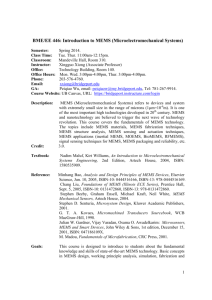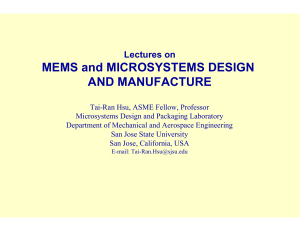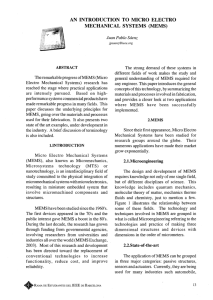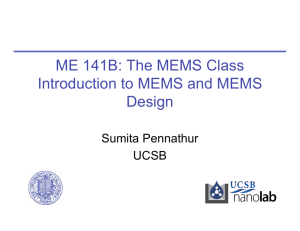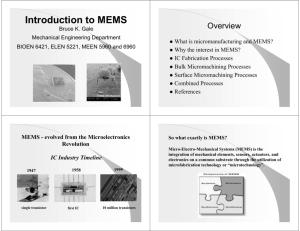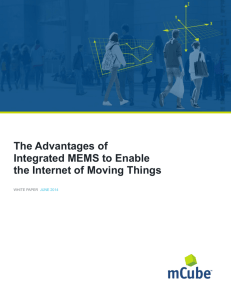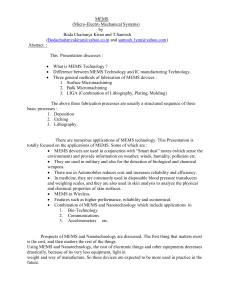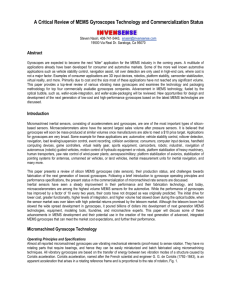Course Outline
advertisement
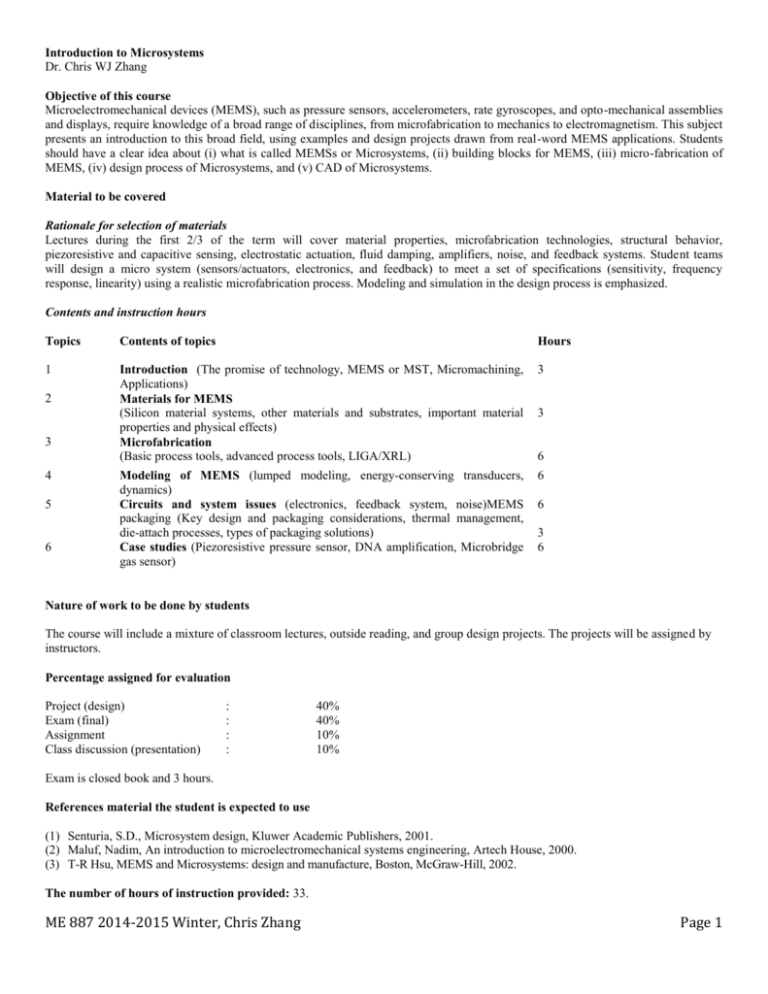
Introduction to Microsystems Dr. Chris WJ Zhang Objective of this course Microelectromechanical devices (MEMS), such as pressure sensors, accelerometers, rate gyroscopes, and opto-mechanical assemblies and displays, require knowledge of a broad range of disciplines, from microfabrication to mechanics to electromagnetism. This subject presents an introduction to this broad field, using examples and design projects drawn from real-word MEMS applications. Students should have a clear idea about (i) what is called MEMSs or Microsystems, (ii) building blocks for MEMS, (iii) micro-fabrication of MEMS, (iv) design process of Microsystems, and (v) CAD of Microsystems. Material to be covered Rationale for selection of materials Lectures during the first 2/3 of the term will cover material properties, microfabrication technologies, structural behavior, piezoresistive and capacitive sensing, electrostatic actuation, fluid damping, amplifiers, noise, and feedback systems. Student teams will design a micro system (sensors/actuators, electronics, and feedback) to meet a set of specifications (sensitivity, frequency response, linearity) using a realistic microfabrication process. Modeling and simulation in the design process is emphasized. Contents and instruction hours Topics Contents of topics Hours 1 Introduction (The promise of technology, MEMS or MST, Micromachining, Applications) Materials for MEMS (Silicon material systems, other materials and substrates, important material properties and physical effects) Microfabrication (Basic process tools, advanced process tools, LIGA/XRL) 3 Modeling of MEMS (lumped modeling, energy-conserving transducers, dynamics) Circuits and system issues (electronics, feedback system, noise)MEMS packaging (Key design and packaging considerations, thermal management, die-attach processes, types of packaging solutions) Case studies (Piezoresistive pressure sensor, DNA amplification, Microbridge gas sensor) 6 2 3 4 5 6 3 6 6 3 6 Nature of work to be done by students The course will include a mixture of classroom lectures, outside reading, and group design projects. The projects will be assigned by instructors. Percentage assigned for evaluation Project (design) Exam (final) Assignment Class discussion (presentation) : : : : 40% 40% 10% 10% Exam is closed book and 3 hours. References material the student is expected to use (1) Senturia, S.D., Microsystem design, Kluwer Academic Publishers, 2001. (2) Maluf, Nadim, An introduction to microelectromechanical systems engineering, Artech House, 2000. (3) T-R Hsu, MEMS and Microsystems: design and manufacture, Boston, McGraw-Hill, 2002. The number of hours of instruction provided: 33. ME 887 2014-2015 Winter, Chris Zhang Page 1 Student Conduct: Ethical behavior is an important part of engineering practice. Each professional engineering association has a Code of Ethics, which its members are expected to follow. Since students are in the process of becoming Professional Engineers, it is expected that students will conduct themselves in an ethical manner. The APEGS (Association of Professional Engineers and Geoscientists of Saskatchewan) Code of Ethics states that engineers shall “conduct themselves with fairness, courtesy and good faith towards clients, colleagues, employees and others; give credit where it is due and accept, as well as give, honest and fair professional criticism” (Section 20(e), The Engineering and Geosciences Professions Regulatory Bylaws, 1997). The first part of this statement discusses an engineer’s relationships with his or her colleagues. One of the ways in which engineering students can demonstrate courtesy to their colleagues is by helping to maintain an atmosphere that is conducive to learning, and minimizing disruptions in class. This includes arriving on time for lectures, turning cell phones and other electronic devices off during lectures, not leaving or entering the class at inopportune times, and refraining from talking to others while the instructor is talking. However, if you have questions at any time during lectures, please feel free to ask (chances are very good that someone else may have the same question as you do). For more information, please consult the University Council Guidelines for Academic Conduct. http://www.usask.ca/university_secretary/council/reports_forms/reports/guide_conduct.php Academic Honesty: The latter part of the above statement from the APEGS Code of Ethics discusses giving credit where it is due. At the University, this is addressed by university policies on academic integrity and academic misconduct. In this class, students are expected to submit their own individual work for academic credit, properly cite the work of others, and to follow the rules for examinations. Academic misconduct, plagiarism, and cheating will not be tolerated. Copying of assignments and lab reports is considered academic misconduct. Students are responsible for understanding the university’s policies on academic integrity and academic misconduct. For more information, please consult the University Council Regulations on Student Academic Misconduct and the university’s examination regulations. http://www.usask.ca/university_secretary/honesty/StudentAcademicMisconduct.pdf http://www.usask.ca/university_secretary/council/academiccourses.php Safety: The APEGS Code of Ethics also states that Professional Engineers shall “hold paramount the safety, health and welfare of the public and the protection of the environment and promote health and safety within the workplace” (Section 20(a), The Engineering and Geosciences Professions Regulatory Bylaws, 1997). Safety is taken very seriously by the Department of Mechanical Engineering. Students are expected to work in a safe manner, follow all safety instructions, and use any personal protective equipment provided. Students failing to observe the safety rules in any laboratory will be asked to leave. ME 887 2014-2015 Winter, Chris Zhang Page 2
